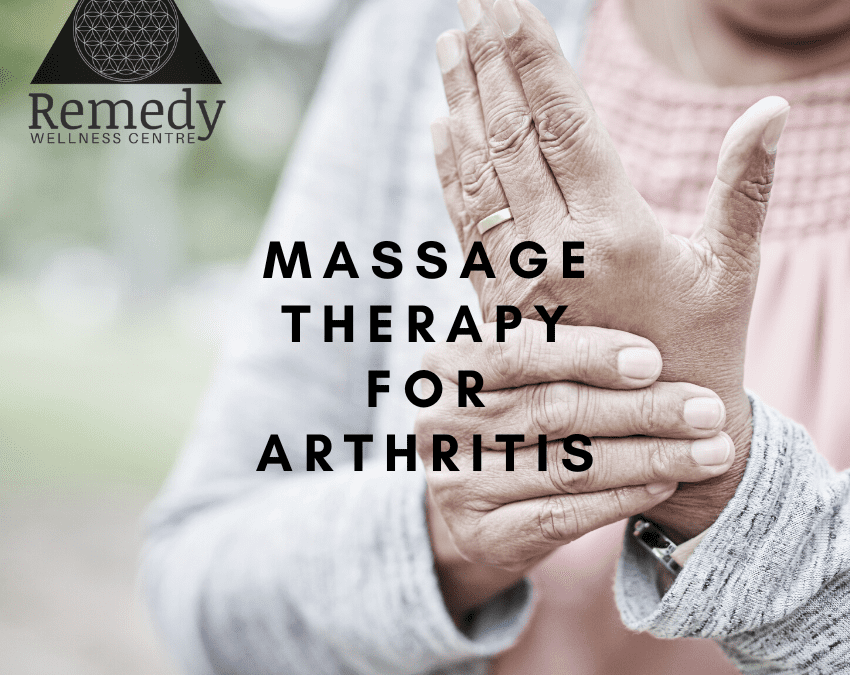Arthritis is a painful condition that many people suffer with. Massage therapy can be an effective, side-effect free complement to your existing arthritis management plan. Have you heard about our Chronic Conditions Program? If you can’t afford to see an RMT (Registered Massage Therapist) for massage therapy for arthritis, you can see one of our Intern Massage Practitioners for a significantly reduces cost.
The term “arthritis” is used to refer to over 100 related joint inflammation conditions. Arthritis can affect anyone at any time. Generally, there are two main types of arthritis; Rheumatoid Arthritis and Osteoarthritis.
Rheumatoid Arthritis vs Osteoarthritis
Rheumatoid arthritis is a chronic systemic autoimmune disease thought to be caused by genetic, lifestyle and/ or environmental factors. It affects the joints, connective tissues, muscle, tendons, and fibrous tissues. Rheumatoid arthritis often strikes during early to mid-adulthood and can be a painful and disabling condition. Early diagnosis is extremely important since arthritis gets progressively worse and therapies work best when started as early as possible. Rheumatoid arthritis can affect multiple organs and cause widespread symptoms including numbness or tingling in the hands and wrists, prolonged aching in the joints, fatigue, locked joints and morning stiffness.
Osteoarthritis is a degenerative joint disease associated with ageing, obesity and/ or previous joint injury. Osteoarthritis is the most prevalent type of arthritis. It generally affects the joints of the body that undergo the most mechanical stress, such as the knees, hips, fingers and lower spine. Osteoarthritis can cause limitations in movement affecting the daily activities of life. Symptoms include joint cracking and creaking, joint swelling and pain, reduced range of motion and muscle weakness.
Massage Therapy for Arthritis
Massage therapy can be an effective, side-effect free complement to your existing arthritis management plan. The specific benefits of massage vary on an individual basis, depending on each individual’s condition. By and large, massage therapy treatment can help reduce the pain and alleviate some of the symptoms of arthritis. Registered massage therapists may help improve function, flexibility and mobility, decrease pressure or tension on joints, improve sleep and reduce anxiety. Massage therapy is often most effective for arthritic hand and knee areas.
All of our massage therapists and intern massage practitioners at Remedy Wellness Centre have experience working with rheumatoid arthritis and osteoarthritis. You’re in good hands here!
Research About Massage and Arthritis
According to a study published in the Archives of Internal Medicine journal, massage therapy can have both immediate and lasting effects on arthritis patients. Researchers found that, in the short term, the sensory input from the massage overrides the pain input in the spinal cord and blocks pain symptoms. Massage therapy can also have a more substantial long-term remedial effect by improving circulation. Increased circulation brings fresh nutrient and oxygen rich blood to the affected area, helps to eliminate cellular wastes and promotes bone and cartilage rebuilding.
Researchers at the Prevention Research Center at Yale University School of Medicine found that adult subjects with osteoarthritis of the knee, had less pain and improved flexibility and range of motion and within eight weeks of beginning regular hour long massage therapy treatments. Best of all, the results were long lasting. Eight weeks following the end of treatment, the subjects were still considerably better than baseline and significantly better than the control group who did not receive massage therapy.
Other effective treatment approaches include acupuncture, chiropractic and athletic therapy
Hydrotherapy for Arthritis
Simply put, hydrotherapy is the use of water, either in liquid, solid or vapour form, for therapeutic reasons. Hydrotherapy is a great compliment to massage therapy both during and in between treatment sessions. Cold, such as in the form of ice or a freezer pack, can combat the inflammation, pain and swelling that accompanies arthritis flare ups. Ice temporarily numbs nerve endings and causes the blood vessels to constrict, which decreases blood flow to an area. Cold therapy should not be applied for longer than 15 minutes at a time. To prevent skin and nerve damage make sure there is a layer of cloth between the ice and the skin.
Exercise for Arthritis
In conjunction with massage therapy, regular physical activity can prevent the worsening of osteoarthritis in older persons, especially. Gentle aerobic exercise (walking, swimming etc.), range-of-motion exercises (stretching) and resistance exercise (muscle strengthening) are all beneficial for patients with osteoarthritis. Registered massage therapists can help to improve quality of life by providing personalized home exercise programs. At Remedy Wellness Centre we can provide our patients with excellent resources for home care including printed exercises with pictures and descriptions or an emailed version with video options. Each home care plan is customized by your therapist to your specific needs.
References:
Archer, Shirley. “Massage Reduces Arthritis Pain.” IDEA Fitness Journal 4.4 (2007): 89.
“Arthritis And Massage Therapy – Improving Mobility And Managing Pain.” Journal Of The Australian Traditional-Medicine Society 17.3 (2011): 191.
http://www.arthritis.ca/aboutarthritis
http://www.webmd.com/osteoarthritis/tc/osteoarthritis-symptoms
http://www.who.int/chp/topics/rheumatic/en/
Ling Qin, et al. “Traditional Chinese Medicine In The Treatment Of Rheumatoid Arthritis: A General Review.” Rheumatology International 30.6 (2010): 713-718.
Noonoo, Stephen. “Working Through The Pain.” Physical Therapy Products 21.4 (2010): 32-33.
Penninix B Wea. Archives of Internal medicine 2001; (161): 2309-2316).
Roberts, D. “Alternative Therapies For Arthritis Treatment: Part 2.” Holistic Nursing Practice 18.3 (2004): 167-174.
Unsal, Ayla, and Sebahat Gözüm. “Use Of Complementary And Alternative Medicine By Patients With Arthritis.” Journal Of Clinical Nursing 19.7-8 (2010): 1129-1138.

